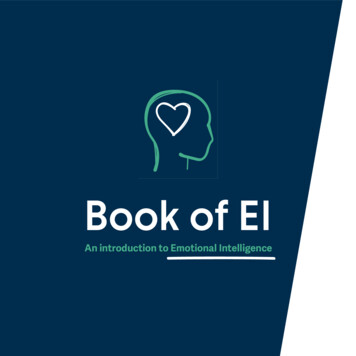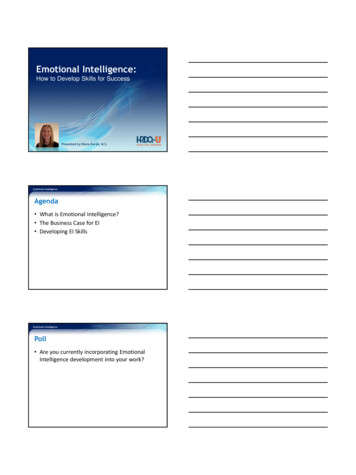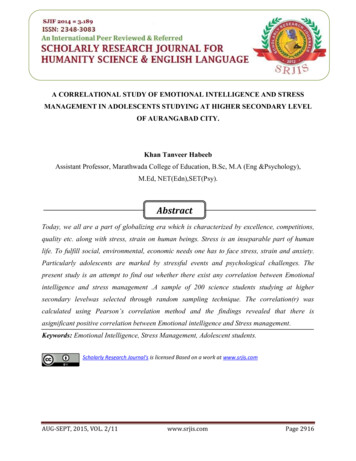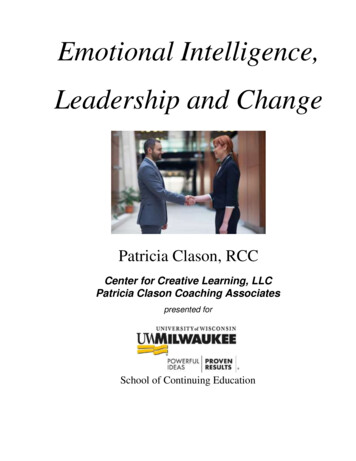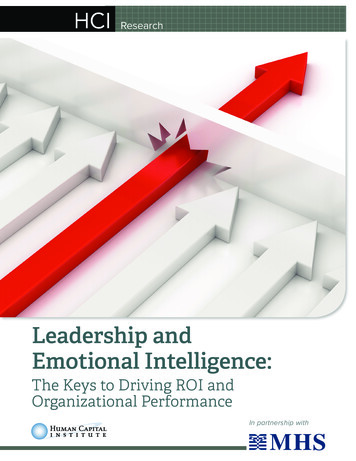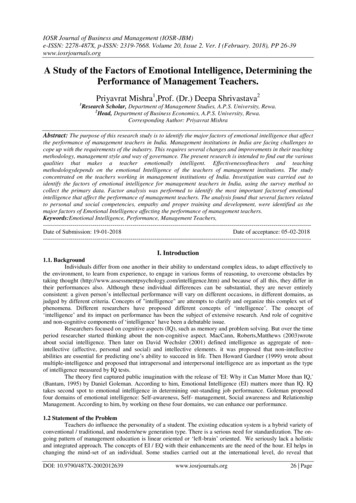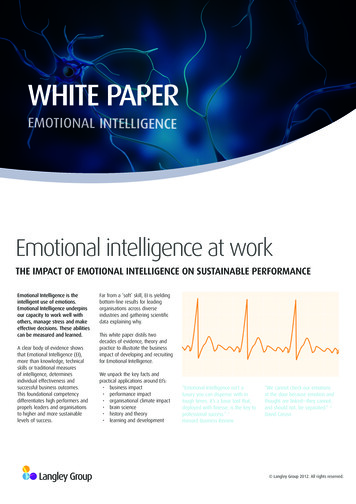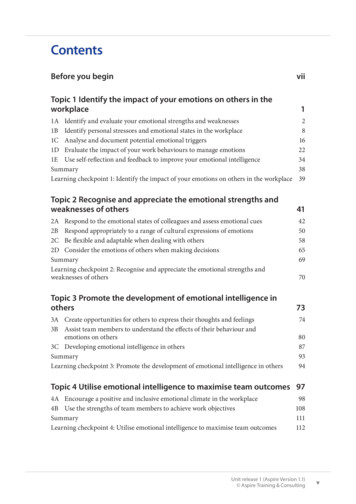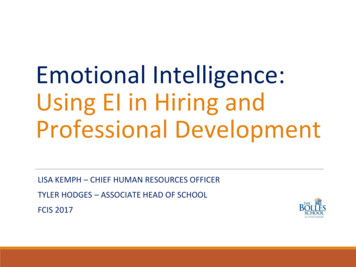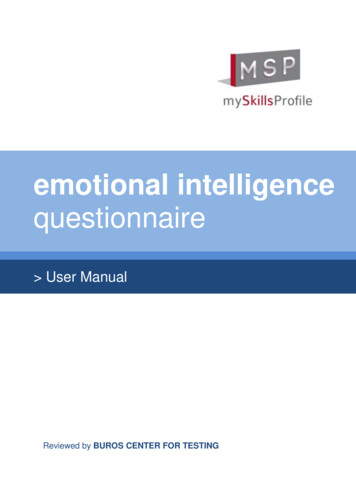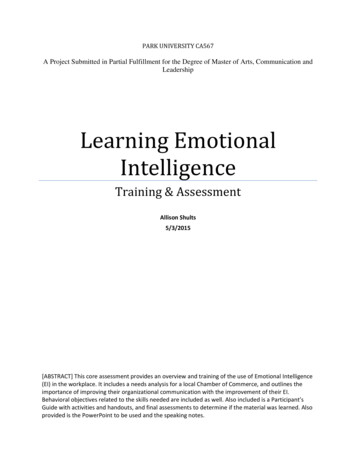
Transcription
PARK UNIVERSITY CA567A Project Submitted in Partial Fulfillment for the Degree of Master of Arts, Communication andLeadershipLearning EmotionalIntelligenceTraining & AssessmentAllison Shults5/3/2015[ABSTRACT] This core assessment provides an overview and training of the use of Emotional Intelligence(EI) in the workplace. It includes a needs analysis for a local Chamber of Commerce, and outlines theimportance of improving their organizational communication with the improvement of their EI.Behavioral objectives related to the skills needed are included as well. Also included is a Participant’sGuide with activities and handouts, and final assessments to determine if the material was learned. Alsoprovided is the PowerPoint to be used and the speaking notes.
A. SHULTS EMOTIONAL INTELLIGENCETable of ContentsEmotional Intelligence Introduction and Task Analysis 2Annotated Bibliography .3-4Needs Analysis and Results .5-6Behavioral Objectives 7Agenda 8-9Participant’s Guide .10-26End of Unit Assessments 20-26References .27PowerPoint and Notes 28-511
A. SHULTS EMOTIONAL INTELLIGENCEIntroduction to Emotional IntelligenceEmotional Intelligence is the ability to recognize and regulate one’s and other’s emotions. The nature ofan effective interpersonal or leadership based relationship involves actively communicating with at leastone other individual, and emotion inevitably arises within conversation. Failing to recognize or manageone’s emotions can cause a lack of understanding, conflict, or unhappiness with self and others.Improving your Emotional Intelligence skills can vastly improve both your career relationships and yourinterpersonal relationshipsTask Analysis: How to Improve Emotional Intelligence Skills1. Identify your motivationa. Learn what Emotional Intelligence isb. Identify why it is important for the workplace2. Increase self-awareness of your emotionsa. Recognize what emotion you feel as it comes upi. Identify emoting words to be able to verbally describe your emotionsii. Identify how you physically express an emotion3. Learn to self-regulate emotionsa. Recognize your current emotioni. Determine if it is positive or negativeb. Employ regulation strategies4. Increase ability to empathizea. Define empathyi. Recognize and change ‘At least ’ statements2
A. SHULTS EMOTIONAL INTELLIGENCE3Annotated BibliographyGrandey, A. A. (2000). Emotion regulation in the workplace: A new way to conceptualizeemotional labor. Journal of Occupational Health Psychology 5(1). 95-110. Retrievedfrom: OHP.pdfThis article discusses emotion in the workplace and the concept of emotional labor. Itprovides an overview of different perspectives of emotional labor, and to describemethods of emotional regulation, from antecedent- and response-focused regulation, aswell as the consequences to regulating emotion. It will be a great resource for thebehavioral objective of emotional regulation.Hein, S. (n.d). A few basic feeling words. EQI. Retrieved from: http://eqi.org/eitoc.htmThis website provides information on Emotional Intelligence. Used in this guide is the listof emotional vocabulary words, from positive to negative.Matsumoto, D., Hwang, S. H., Skinner, L., Frank, M. (2011). Evaluating Truthfulness andDetecting Deception. FBI Law Enforcement Bulletin. Retrieved fulness-and-detecting-deceptionThis web article discusses how to detect deception from an investigation standpoint. Itnotes behavioral and nonverbal cues, microexpressions, and analyzing statements. Of usein my assessment is the picture of universal emotions.The Quick Emotional Intelligence Self-Assessment. (n.d.). San Diego City College. Retreivedfrom: http://www.sdcity.edu/portals/0/cms editors/mesa/pdfs/emotionalintelligence.pdfThis assessment will be used to determine the trainees level of perceived EmotionalIntelligence before and after the training.
A. SHULTS EMOTIONAL INTELLIGENCE4The RSA (Producer). (2013). Brené Brown on Empathy [Video]. Available from:https://www.youtube.com/watch?v 1Evwgu369Jw&desktop uri %2Fwatch%3Fv%3D1Evwgu369Jw&app desktopThis video defines the concept of empathy, and will be shown to describe what empathymeans for the trainees.Sigmar, L. S., Hynes, G. E., & Hill, K. L. (2012). Strategies for Teaching Social and EmotionalIntelligence in Business Communication. Business Communication Quarterly, 75(3),301-317. doi:10.1177/1080569912450312This article will provide support for implementing Emotional Intelligence training plans.It discusses the theory behind EI, including how it is implemented in the workplace andthe scientific support of it. It also provides examples of activities used in the developmentof EI in students. Of note is the section on the importance of EI.Wood, J. T. (2013). Interpersonal communication: Everyday encounters. (7th ed.). Belmont:Wadsworth.This textbook provides an in-depth look of interpersonal communication, and coversinformation of the general and specific nature, from communication in perception tocommunication in relationships, and more. Of use in this training is the chapter onemotion within communication, and the definitions and examples of EmotionalIntelligence.
A. SHULTS EMOTIONAL INTELLIGENCE5Needs Analysis and ResultsThe organization that I will be proposing my consulting session to is a local Chamber ofCommerce. The Chamber works within the community as a beacon for the local businesses, andtries to ensure their success through networking, development, education, etc. The organizationfocuses on economic development and communicating with local businesses about their interestswithin the community, providing information on local legislature that may influence businesspractices, and acts as an organization of resources for others. The Chamber has been establishedin the community for over a century, positioning the organization in a way that allows employeesto work one on one with many local businesses and potential business transplants. Because ofthis, the Chamber must ensure their employees can show the utmost level of customer serviceand communication tact with individuals whom have a wide variety of backgrounds.Unfortunately, this has not always been the case. The level of effective communicationwith the team members of the organization has gone down, and this has been sensed by thecommunity as well. The organization consists of employees of multiple generations, andconstructive communication is not often used. The relationships of the employees need to beimproved internally, and they need to learn to professionally communicate with and understandeach other, so that tension is not leaked outward to be sensed by those in the community (P.Shults, personal communication, April 2, 2015). Increasing Emotional Intelligence for theseemployees can lead to enhanced communication and workplace relationships, and research haseven suggested Emotionally Intelligent individuals often show higher problem-solving,performance, and leadership abilities (Sigmar, Hynes, & Hill, p. 305).
A. SHULTS EMOTIONAL INTELLIGENCEPlease circle to what extent you agree with each of the following statements:1. I can express my emotions freely at my place of work.Strongly DisagreeDisagreeUndecidedAgreeStrongly AgreeAgreeStrongly Agree2. My coworkers take notice when I am upset.Strongly DisagreeDisagreeUndecided3. If I am having difficulty with a coworker, I feel comfortable talking to my supervisorabout it.Strongly DisagreeDisagreeUndecidedAgreeStrongly AgreeAgreeStrongly Agree4. I like to talk to others about my emotions.Strongly DisagreeDisagreeUndecidedPlease circle the degree to which each statement occurs daily:5. My coworkers ask how I am doing in the morning, and take time to listen to my answer.NeverRarelyNot SureOftenAlways6. I ask my coworkers how they are feeling and genuinely listen.NeverRarelyNot SureOftenAlways7. I can recognize what emotion I am feeling when it arises.NeverRarelyNot SureOftenAlwaysPlease answer to the best of your ability:8. Are there rules regarding expressing emotion in your company?9. What is your standard practice when a coworker or business prospect makes you angry?6
A. SHULTS EMOTIONAL INTELLIGENCE7Behavioral ObjectivesAt the end of the unit, the trainee will be able to:1. Demonstrate increased vocabulary of emotion words based on a pre- and post-test.2. Recognize the strategies for emotional self-regulation in work environments: SituationSelection, Situation Modification, Attention Deployment, Cognitive Change, SurfaceActing.3. Demonstrate understanding of empathy as discussed in the Brené Brown on Empathyvideo.4. Demonstrate an increase in Overall Perceived Emotional Intelligence as measured by theEmotional Intelligence Self-Assessment taken at the beginning and end of the training.
A. SHULTS EMOTIONAL INTELLIGENCE8AgendaLecture (10 minutes)I.II.III.Introduce myself and why I am doing this trainingEstablish a definition of Emotional Intelligence [Slide 1]Establish why Emotional Intelligence is important to the individuals and theorganization [Slide 2]Activity (15 minutes)I.Each individual determines their current level of perceived Emotional IntelligenceA. Each individual takes the Emotional Intelligence Self-Assessment [p. 18 inParticipant’s Guide]Activity (3 minutes)I.Take the Emoting Words Pre-Test to determine the established emotional vocabulary[p. 4 in Participant’s Guide]Lecture/Discussion (15 minutes)I.Establish the importance of an emotional vocabularyA. Discuss potential positive words that may be used in the work environment[Slide 5 or p. 6 in Participant’s Guide]a. Propose questions for group discussion on the consequences of thelanguageB. Discuss potential negative words that may be used in the work environment[Slide 6 or p. 6 in Participant’s Guide]a. Propose questions for group discussion on the consequences of thelanguageActivity/Discussion (10 minutes)I.Take the Emotional Expressions quiz [Slide 8 or p. 7 in Participant’s Guide]A. Discuss how the ability to recognize and express emotions impacts workenvironment-- 5 Minute Break -Lecture/Discussion (15 minutes)I.Discuss the Communication Continuum and how each level relates to EmotionalIntelligence [Slide 11 or p. 9 of Participant’s Guide]A. Present examples for each level and discuss as a group [Slides 12-14 or p. 10in Participant’s Guide]
A. SHULTS EMOTIONAL INTELLIGENCE9Lecture/Discussion (15 minutes)I.II.Establish strategies for emotional regulationA. Provide definitions for Antecedent-Focused and Response-Focused strategies[Slide 16 or p. 11 in Participant’s Guide]Provide examples and discuss what emotional regulation strategy is used, benefits orconsequences [Slide 17-19 or p. 12 in Participant’s Guide]-- 10 Minute Break –Video (3 minutes)I.Watch Brené Brown’s talk on empathy [linked to Slide 21 or p. 13 in Participant’sGuide]Discussion (5 minutes)I.II.Discuss how empathy or a lack of empathy can impact daily work environmentDiscuss in groups of 3 times when you could have been more empathetic at workKnowledge Checks/Discussion (20 minutes)I.II.III.IV.Take Emotional Regulation quiz [p. 14 in Participant’s Guide]A. Discuss results with a partner. As a group, discuss whether you think you willuse these strategies [Answers provided on p. 15 in Participant’s Guide]Take Empathy Quiz [p. 16 in Participant’s Guide]A. Discuss examples with a partner. Do you feel empathy is important to yourjob?Take Emoting Words Post-TestA.Discuss as a group whether you had improvements and find these wordshelpfulTake Emotional Intelligence Self-Assessment again to see if there is improvement-- Open Floor For Questions or Concerns --
A. SHULTS EMOTIONAL INTELLIGENCEParticipant’s GuideTable of Contents:Emoting Words Pre-Test .12Emoting Words Examples .13Identifying Emotional Expressions Activity .14Activity Answers & Discussion . 15Communication Continuum Diagram .16Scenarios & Discussion .17Regulating Emotions 18Emotional Regulation Discussion .19Brené Brown: Explaining Empathy .20End of Training AssessmentsEmotional Regulation Knowledge Check .21Answers .22Empathy Quiz 23Emoting Words Post-Test .24EI Self-Assessment 25-2710
A. SHULTS EMOTIONAL INTELLIGENCEEmoting Words Pre-TestIn the following box, list as many “Positive” emotions as you can:Now, in the following box, list as many “Negative” emotions as you can:11
A. SHULTS EMOTIONAL INTELLIGENCEEmotive Words You May Usein the Workplace(Hein, S., ncompetentTrappedInvalidated12
A. SHULTS EMOTIONAL INTELLIGENCE13Can You Name the 7 Universal Facial Expressionsof Emotion?(Matsumoto, D., Hwang, S. H., Skinner, L., Frank, M., 2011).624137* Fear* Anger* Surprise* Disgust* Contempt* Sadness* Happiness5In this activity, write the number corresponding to the picture next to the emotion on the rightthat best describes it. When everyone is finished, we’ll reveal the results.
A. SHULTS EMOTIONAL INTELLIGENCETurn to the person on your left and discuss:How did you do?Which emotions were difficult to match?Which emotions were easy?How does each emotion impact your work environment?14
A. SHULTS EMOTIONAL personalThe Communication Continuum(Wood, J. T., 2011, p. 18-19).I-It Communication: Impersonal interactions with others, in which we do not acknowledge anindividual as a human, rather as a means to achieve something.I-You Communication: Interactions with others in which we acknowledge them as more than ameans to an end, but still do not fully recognize that they are individual, unique people. Rather,the interactions are still based largely on the roles the individual plays in our life.I-Thou Communication: Truly interpersonal interactions in which we recognize the individualas a unique human being that we can express our true feelings with, and express and acceptourselves and others as we are.
A. SHULTS EMOTIONAL INTELLIGENCE16We will read the following scenarios and discuss one by one in which area of the spectrumthey fall, and whether they have employed Emotional Intelligence:1. Rebecca runs into her co-worker at the coffee shop on their way to work Mondaymorning.“Hi Jessica, how are you this morning?” she asks. Jessica responds by mentioning howtired she is on Monday’s, to which Rebecca commiserates about how much she wishesthe weekend were a day longer. Jessica gets her coffee, and tells Rebecca to have a greatday if she doesn’t see her again. What kind of communication has Rebecca and Jessicaentered, and what kind of emotional intelligence strategies were used?2. John works for a large corporation, whose Human Resources department is located withheadquarters in another state. When John calls HR with a question about his benefits, therepresentative sounds rushed and annoyed, and asks for his Employee ID Number beforehis name, which makes John feel as though he is just a number in this company. He is notfeeling valued as an employee or a person. What kind of communication has Johnentered, and how could increased emotional intelligence by HR change thiscommunication?3. Sam has just had a death in the family, and needs to speak to his boss about takingbereavement time off. He tries to remain professional in his conversation, but starts to getemotional as he meets with his boss. He explains that he doesn’t think he will be able toperform as well as he should because of his emotional state. Sam feels vulnerable andnervous to be so open in front of a superior, but his boss reacts with friendlyunderstanding, and affirms that of course he can take some time, letting him know thatshe understands how hard it can be. What kind of communication has Sam entered andwhat emotional intelligence skills were used?
A. SHULTS EMOTIONAL INTELLIGENCERegulating Emotions(Grandey, A. A., 2000, p. 98-99)Antecedent-Focused Emotional RegulationSituation ModificationSituation SelectionChoosing the situationswe place ourselves inChoosing to change asituation we arecurrently in, by leavingor stepping away ifnecessaryAttention DeploymentCognitive ChangeThinking about othertimes we felt theemotion we wish tocurrently feel, in order toexpress it in our currentsituationChanging the way weperceive a situation inorder to change the waywe feel about itResponse-Focused Emotional RegulationSurface ActingChanging our emotionalexpression, rather thanour actual internalfeelings17
A. SHULTS EMOTIONAL INTELLIGENCE18Emotional Regulation DiscussionExample 1:Sarah works at a retail store and sees a customer enter who had previously spokendiscriminatorily to her. She becomes angry when she sees this customer. Rather than yell at thecustomer, Sarah goes into the break room. What type of Emotional Regulation did Sarah use?What consequences does this type of regulation come with? Could there have been a better wayto handle this interaction?Example 2:Jack has been having a very bad day and is near the end of his shift. He is tired and hungry buthe must attend his last meeting of the day. When he meets with his client, he is smiling andcheerful, despite his mood. What type of Emotional Regulation did Jack employ? Whatconsequences does this type of regulation come with? Could there have been a better way tohandle this interaction?Example 3:Omar is on his way to meet with a group of clients when his boss stops him. “I wanted to warnyou that this group has just had a major public scandal released, and you may need to approachthem lightly,” she says. When Omar meets with the group, he notices that the group is actingvery defensive with all of his questions. Rather than become offended, Omar looks at the groupkeeping in mind what his boss has told him, and acts more empathetic towards them. What typeof Emotional Regulation did Omar employ? What consequences does this type of regulationcome with? Could there have been a better way to handle this interaction?
A. SHULTS EMOTIONAL INTELLIGENCE19View the video of Brené Brown’s explanation of empathy:https://www.youtube.com/watch?v 1Evwgu369Jw&desktop uri %2Fwatch%3Fv%3D1Evwgu369Jw&app desktopDiscuss as a group:How might a lack of empathy impact your daily work interactions?Think of a time when you might have offered an ‘At least ’ response. How might you respondmore empathetically?
A. SHULTS EMOTIONAL INTELLIGENCE20End of Unit AssessmentsEmotional Regulation Knowledge Quiz1. Respondent-Focused emotional regulation occurs before the emotional response.a. Trueb. False2. Jane chooses not to pursue a career as a Veterinarian because she believes that seeinghurt animals will be too hard on her emotional state. Jane is employing .a. Attention Deploymentb. Situation Modificationc. Situation Selectiond. Cognitive Changee. Surface Acting3. Grady is being yelled at by a customer. Rather than yelling back, he excuses himself fromthe conversation and takes a moment to calm down away from the customer. Grady hasused the emotional regulation strategy.a. Surface Actingb. Attention Deploymentc. Cognitive Changed. Situation Modificatione. Situation Selection4. Mary likes to whistle while she works because music has always made her happy. Maryis using the Cognitive Change strategy.a. Trueb. False5. Putting on a “mask” to appear friendly to customers is considered .a. Situation Selectionb. Cognitive Changec. Surface Actingd. Attention Deploymente. Situation Modification6. Steve gets nervous when he speaks publicly, so his boss has told him to try thinking of aspeech as a challenge he will overcome rather than an anxiety inducing event. Steve’sboss wants him to use .a. Cognitive Changeb. Attention Deploymentc. Situation Selectiond. Situation Modificatione. Surface Acting
A. SHULTS EMOTIONAL INTELLIGENCEEmotional Regulation Knowledge Quiz Answers1.2.3.4.5.6.FalseA – Situation SelectionD – Situation ModificationFalseC – Surface ActingA – Cognitive Change21
A. SHULTS EMOTIONAL INTELLIGENCEEmpathy Is .Provide examples of the 4 qualities of empathy:1. Perspective Taking –2. Staying out of Judgement –3. Recognizing other’s emotion and communicating it –4. Connecting to something in yourself that knows the feeling of the other -22
A. SHULTS EMOTIONAL INTELLIGENCEEmoting Words Post-TestIn the following box, list as many “Positive” emotions as you can:Now, in the following box, list as many “Negative” emotions as you can:For discussion, compare to your Pre-Test:How many words were the same?How many words did you learn?Will you be able to use these words with co-workers and superiors?23
A. SHULTS EMOTIONAL INTELLIGENCE24The Quick Emotional Intelligence Self-Assessment** Adapted for this training from the works of the San Diego City College MESA Program, which was adapted froma model by Paul Mohapel (paul.mohapel@shaw.ca)Rank each statement as follows: 0 (Never) 1 (Rarely) 2 (Sometimes) 3 (Often) 4 (Always)We’ll be taking this assessment twice! For the first round, write totals in the first blank. For the final round, writetotals in the second blank.Emotional Awareness – Total:0123 4 My feelings are clear to me at any given moment0123 4 Emotions play an important part in my life01230123 4 I find it easy to put words to my feelings0123 4 My moods are easily affected by external events0123 4 I can easily sense when I’m going to be angry012 30123 4 I find it easy to describe my feelings01230123 4 I’m able to stand apart from my thoughts and feelings and examine them4 My moods impact the people around me4 I readily tell others my true feelings4 Even when I’m upset, I’m aware of what’s happening to meEmotional Management – Total:0123 4 I accept responsibility for my reactions0123 4 I find it easy to make goals and stick with them01234 I am an emotionally balanced person
A. SHULTS EMOTIONAL INTELLIGENCE0123 4 I am a very patient person0123 4 I can accept critical comments from others without becoming angry0123 4 I maintain my composure, even during stressful times012 30123 4 I can restrain myself when I feel anger towards someone01230123 4 I direct my energy into creative work or hobbies4 If an issue does not affect me directly, I don’t let it bother me4 I control urges to overindulge in things that could damage my well beingSocial Emotional Awareness – Total:0123 4 I consider the impact of my decisions on other people0123 4 I can easily tell if the people around me are becoming annoyed01230123 4 I am able to be supportive when giving bad news to others0123 4 I am generally able to understand the way other people feel0123 4 My friends can tell me intimate things about themselves012 30123 4 I usually know when to speak and when to be silent01230123 4 I understand when people’s plans change4 I sense it when a person’s mood changes4 It genuinely bothers me to see other people suffer4 I care what happens to other people25
A. SHULTS EMOTIONAL INTELLIGENCE26Your EQ Strengths: Check your EQ total scores to assess your strengths and areas forimprovement.DomainScoreEmotional Awareness0 2 4 6 8 10 12 14 16 18 20 22 24 26 28 30 32 34 36 38 40Emotional Management0 2 4 6 8 10 12 14 16 18 20 22 24 26 28 30 32 34 36 38 40Social Emotional Awareness0 2 4 6 8 10 12 14 16 18 20 22 24 26 28 30 32 34 36 38 400-24Area for Enrichment: Requires attention and development25-34 Effective Functioning: Consider Strengthening35-40 Enhanced Skills: Use as leverage to develop weaker areas(Quick Emotional, n.d.)
A. SHULTS EMOTIONAL INTELLIGENCE27ReferencesGrandey, A. A. (2000). Emotion regulation in the workplace: A new way to conceptualizeemotional labor. Journal of Occupational Health Psychology 5(1). 95-110. Retrievedfrom: OHP.pdfHein, S. (n.d). A few basic feeling words. EQI. Retrieved from: http://eqi.org/eitoc.htmMatsumoto, D., Hwang, S. H., Skinner, L., Frank, M. (2011). Evaluating Truthfulness andDetecting Deception. FBI Law Enforcement Bulletin. Retrieved fulness-and-detecting-deceptionThe Quick Emotional Intelligence Self-Assessment. (n.d.). San Diego City College. Retreivedfrom: http://www.sdcity.edu/portals/0/cms editors/mesa/pdfs/emotionalintelligence.pdfThe RSA (Producer). (2013). Brené Brown on Empathy [Video]. Available from:https://www.youtube.com/watch?v 1Evwgu369Jw&desktop uri %2Fwatch%3Fv%3D1Evwgu369Jw&app desktopSigmar, L. S., Hynes, G. E., & Hill, K. L. (2012). Strategies for Teaching Social and EmotionalIntelligence in Business Communication. Business Communication Quarterly, 75(3),301-317. doi:10.1177/1080569912450312Wood, J. T. (2013). Interpersonal communication: Everyday encounters. (7th ed.). Belmont:Wadsworth.
A. SHULTS EMOTIONAL INTELLIGENCE28Accompanying PowerPointEmotional intelligence is essentially the ability to recognize and control our emotions and thoseof others, to understand why someone is feeling what they are, to express emotion in a wayproductive to the conversation, to use the knowledge of our and others emotions as a motivationtool and a guide to build relationships. It allows us not only to recognize our emotions andexpressions, but to see how those affect others. With high emotional intelligence, we are able toknow our own feelings, know how to regulate them when dealing with others, and to improverelationships with others by recognizing their emotions (Wood, 2013).
A. SHULTS EMOTIONAL INTELLIGENCE29The nature of an effective interpersonal or leadership based relationship involves activelycommunicating with at least one other individual, and emotion inevitably arises withinconversation. Failing to recognize or manage one’s emotions can cause a lack of understanding,conflict, or unhappiness with self and others. Increases in emotional intelligence will benefityour interpersonal and work-related communication and relationships.In this day and age, diversity and technology increases in the workplace have impacted workenvironments, and consequently the ability to work as a team and communicate effectively.Increasing emotional intelligence will allow us to communicate better with each other in thisenvironment, as well as with potential clients, business men and women, supervisors, etc.Research has even shown that emotionally intelligent individuals are likely to positively impactmanagement and strategic process (Sigmar, L. Hynes, & Hill, 2008).Research has shown that suppressing emotions or expressing non-genuine emotions while atwork can result in high levels of job stress and often, burnout (Grandey, 2000).
A. SHULTS EMOTIONAL INTELLIGENCE30I have no doubt that many of you already display levels of emotional intelligence. Let’s start bytaking this quick assessment that we’ll take again after the training. P. 27 in Participant’s Guide.
A. SHULTS EMOTIONAL INTELLIGENCE31Take the Emoting words pre-test. P. 14 in Participant’s Guide.An emotional vocabulary is a building block to emotional intelligence. Research has shown thatincreased emotional vocabulary can alleviate the effects of negative emotions, which isextremely important in the regulation of emotion (Sigmar, Hynes, Hill, 2012).Establishing an emotional vocabulary also allows you to improve your communication regardingemotion, which in turn will allow you to express your own emotions better, as well as betterrecognize the emotions of others.
A. SHULTS EMOTIONAL INTELLIGENCEP. 15 in Participant’s Guide.Ask: Do you hear these words from your supervisor? From your co-workers? Clients? Howcould use of these words impact the culture of the office? (Hein, n.d.).32
A. SHULTS EMOTIONAL INTELLIGENCEAlso found on p. 15 in Participant’s Guide.Ask: Do you hear these words often from supervisors? Coworkers? Clients? How could use ofthese words impact the culture of the office? (Hein, n.d.)33
A. SHULTS EMOTIONAL INTELLIGENCETurn to p. 16 for activity.34
A. SHULTS EMOTIONAL INTELLIGENCE35P.16 in Participant’s Guide. Write the picture # next to the correct emotion. (Matsumoto, Hwang,Skinner, & Frank, 2011).
A. SHULTS EMOTIONAL INTELLIGENCE36P. 17 in Participant’s GuideSo what’s the point? Being able to recognize basic emotions will allow you to learn how to reactto them, how to regulate, how to empathize with others, and to direct actions and conversation inthe necessary way. Use the discussion questions to ask yourselves: when I see someone begin toexhibit these very basic emotions, how does that impact my environment and conversation?What can I do to change it?(Matsumoto, Hwang, Skinner, & Frank, 2011).
A. SHULTS EMOTIONAL INTELLIGENCE37Bathroom/snack break time. 5 min. When we come back we’ll start talking about communicationsituations and how to regulate the emotions that come up.
A. SHULTS EMOTIONAL INTELLIGENCE38P. 18 in Participant’s Guide.Bottom level: individuals are treated as a means to an end, rather than a human – a server orcustomer service employee.Middle: they are more than a means to an end, but still we base our interactions with themlargely on their social roles within our lives – likely coworkers, supervisors, clients. We areinteracting with them because of who they are to us, rather than just who they are.Top – truly interpersonal, the individual is unique and we care about their feelings, and feel closeenough to express our own (Wood, 2013).These levels dictate the type of communication we have, and consequently the amount ofemotional
Establish a definition of Emotional Intelligence [Slide 1] III. Establish why Emotional Intelligence is important to the individuals and the organization [Slide 2] Activity (15 minutes) I. Each individual determines their current level of perceived Emotional Intelligence A. Each individual takes the Emotional Intelligence Self-Assessment [p. 18 in
